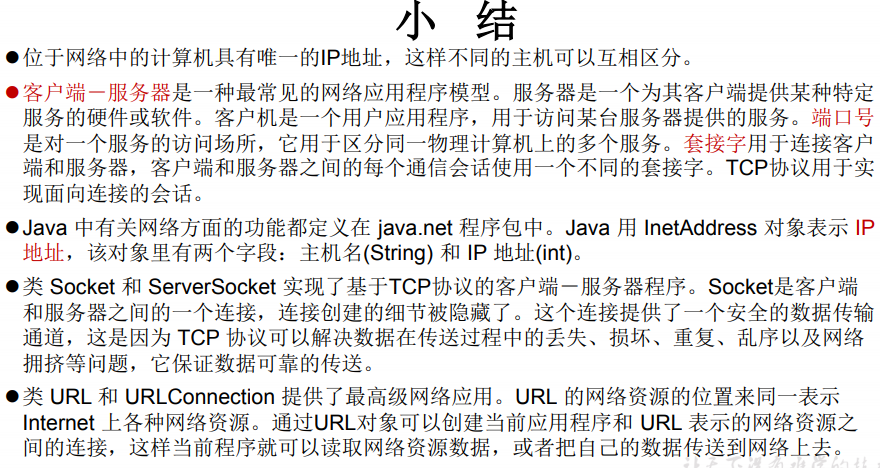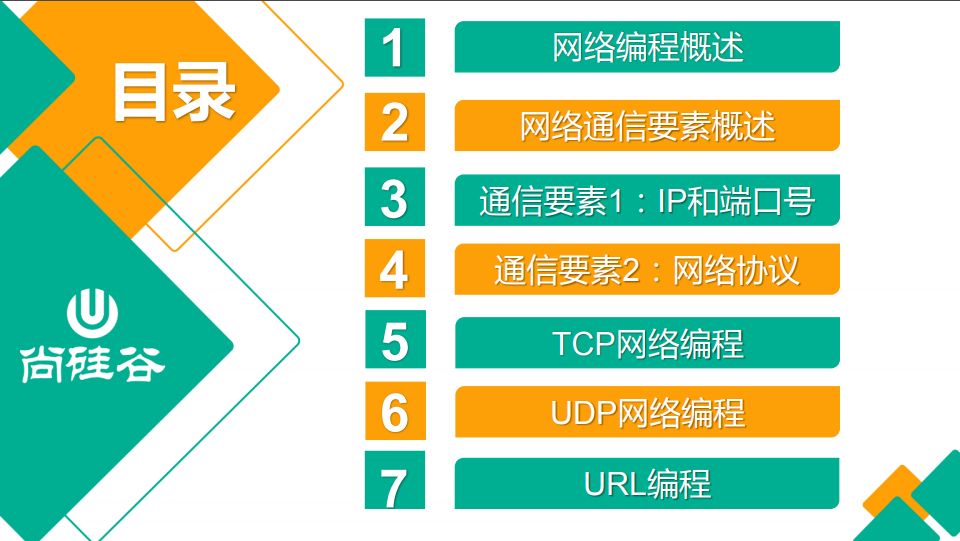
Java提供的网络类库,可以实现无痛的网络连接,联网的底层 细节被隐藏在 Java 的本机安装系统里,由 JVM 进行控制。并 且 Java 实现了一个跨平台的网络库,程序员面对的是一个统一 的网络编程环境。详细可以看学习资料里的ppt
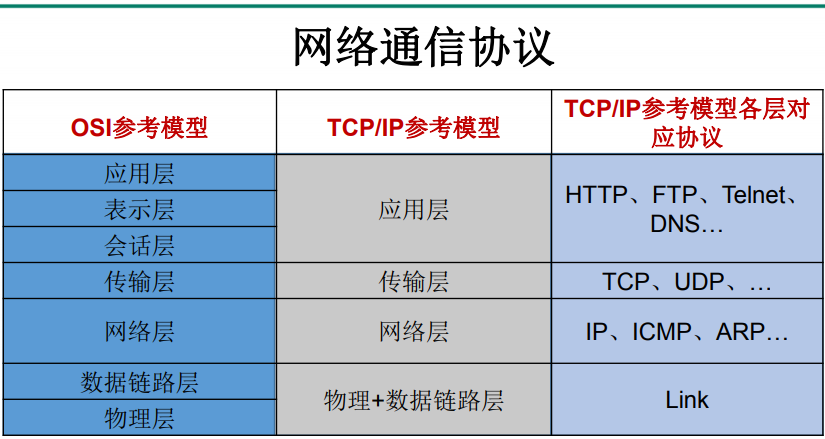
Internet上的主机有两种方式表示地址: 域名(hostName):www.atguigu.com
IP 地址(hostAddress):202.108.35.210
域名容易记忆,当在连接网络时输入一个主机的域名后,域名服务器(DNS) 负责将域名转化成IP地址,这样才能和主机建立连接。 -------域名解析
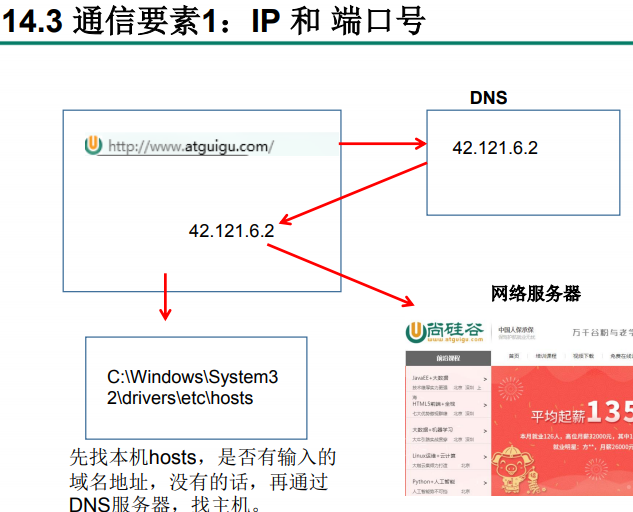


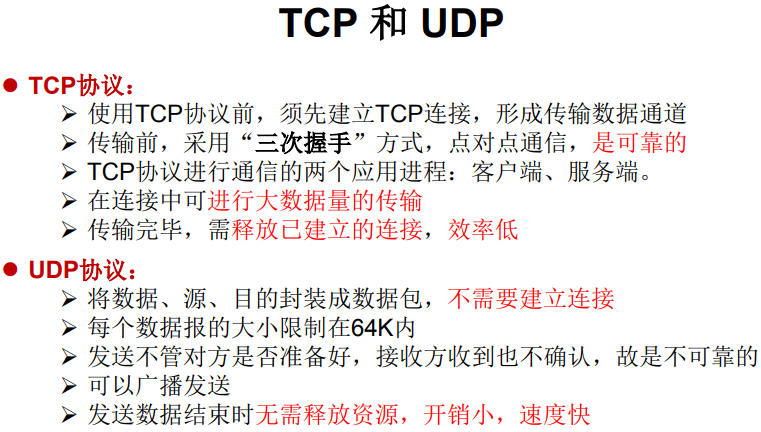
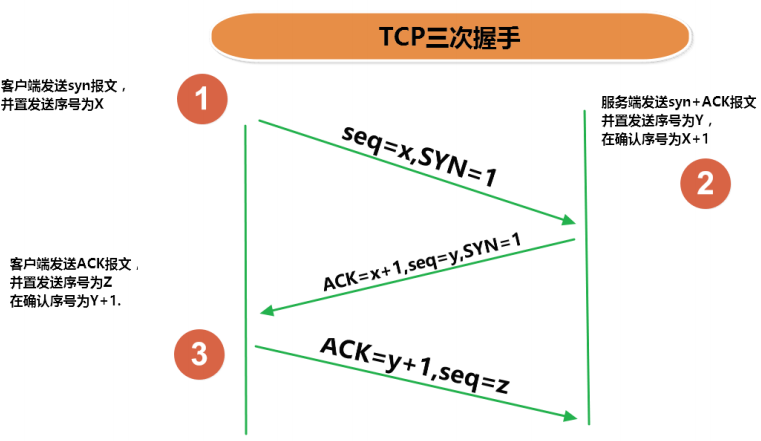
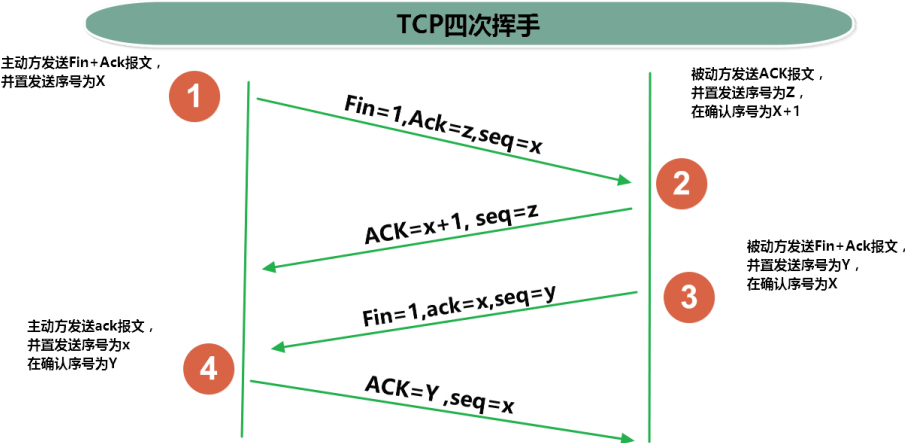

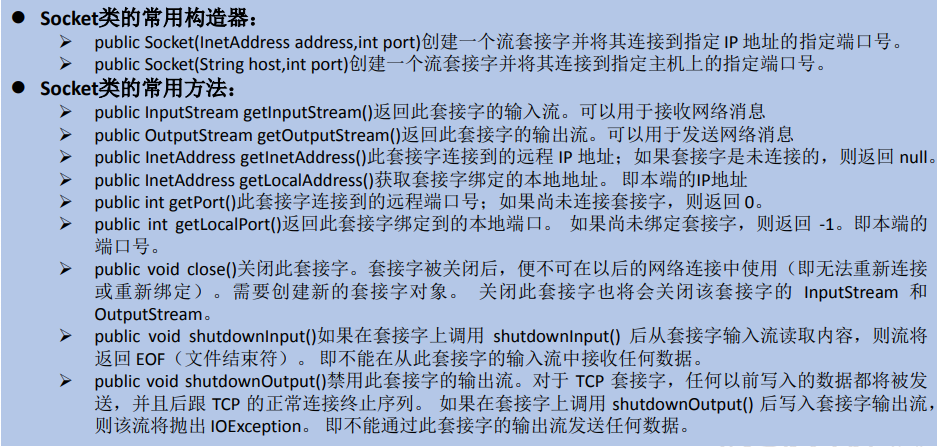



package com.atguigu.java1; import java.net.InetAddress; import java.net.UnknownHostException; /** * 一、网络编程中有两个主要的问题: * 1.如何准确地定位网络上一台或多台主机;定位主机上的特定的应用 * 2.找到主机后如何可靠高效地进行数据传输 * * 二、网络编程中的两个要素: * 1.对应问题一:IP和端口号 * 2.对应问题二:提供网络通信协议:TCP/IP参考模型(应用层、传输层、网络层、物理+数据链路层) * * * 三、通信要素一:IP和端口号 * * 1. IP:唯一的标识 Internet 上的计算机(通信实体) * 2. 在Java中使用InetAddress类代表IP * 3. IP分类:IPv4 和 IPv6 ; 万维网 和 局域网 * 4. 域名: www.baidu.com www.mi.com www.sina.com www.jd.com * www.vip.com * 5. 本地回路地址:127.0.0.1 对应着:localhost * * 6. 如何实例化InetAddress:两个方法:getByName(String host) 、 getLocalHost() * 两个常用方法:getHostName() / getHostAddress() * * 7. 端口号:正在计算机上运行的进程。 * 要求:不同的进程有不同的端口号 * 范围:被规定为一个 16 位的整数 0~65535。 * * 8. 端口号与IP地址的组合得出一个网络套接字:Socket * @author shkstart * @create 2019 下午 2:30 */ public class InetAddressTest { public static void main(String[] args) { try { //File file = new File("hello.txt"); InetAddress inet1 = InetAddress.getByName("192.168.10.14"); System.out.println(inet1); InetAddress inet2 = InetAddress.getByName("www.atguigu.com"); System.out.println(inet2); InetAddress inet3 = InetAddress.getByName("127.0.0.1"); System.out.println(inet3); //获取本地ip InetAddress inet4 = InetAddress.getLocalHost(); System.out.println(inet4); //getHostName() System.out.println(inet2.getHostName()); //getHostAddress() System.out.println(inet2.getHostAddress()); } catch (UnknownHostException e) { e.printStackTrace(); } } }

package com.atguigu.java1; import org.junit.Test; import java.io.ByteArrayOutputStream; import java.io.IOException; import java.io.InputStream; import java.io.OutputStream; import java.net.InetAddress; import java.net.ServerSocket; import java.net.Socket; /** * 实现TCP的网络编程 * 例子1:客户端发送信息给服务端,服务端将数据显示在控制台上 * * @author shkstart * @create 2019 下午 3:30 */ public class TCPTest1 { //客户端 @Test public void client() { Socket socket = null; OutputStream os = null; try { //1.创建Socket对象,指明服务器端的ip和端口号 InetAddress inet = InetAddress.getByName("192.168.14.100"); socket = new Socket(inet,8899); //2.获取一个输出流,用于输出数据 os = socket.getOutputStream(); //3.写出数据的操作 os.write("你好,我是客户端mm".getBytes()); } catch (IOException e) { e.printStackTrace(); } finally { //4.资源的关闭 if(os != null){ try { os.close(); } catch (IOException e) { e.printStackTrace(); } } if(socket != null){ try { socket.close(); } catch (IOException e) { e.printStackTrace(); } } } } //服务端 @Test public void server() { ServerSocket ss = null; Socket socket = null; InputStream is = null; ByteArrayOutputStream baos = null; try { //1.创建服务器端的ServerSocket,指明自己的端口号 ss = new ServerSocket(8899); //2.调用accept()表示接收来自于客户端的socket socket = ss.accept(); //3.获取输入流 is = socket.getInputStream(); //不建议这样写,可能会有乱码 // byte[] buffer = new byte[1024]; // int len; // while((len = is.read(buffer)) != -1){ // String str = new String(buffer,0,len); // System.out.print(str); // } //4.读取输入流中的数据 baos = new ByteArrayOutputStream(); byte[] buffer = new byte[5]; int len; while((len = is.read(buffer)) != -1){ baos.write(buffer,0,len); } System.out.println(baos.toString()); System.out.println("收到了来自于:" + socket.getInetAddress().getHostAddress() + "的数据"); } catch (IOException e) { e.printStackTrace(); } finally { if(baos != null){ //5.关闭资源 try { baos.close(); } catch (IOException e) { e.printStackTrace(); } } if(is != null){ try { is.close(); } catch (IOException e) { e.printStackTrace(); } } if(socket != null){ try { socket.close(); } catch (IOException e) { e.printStackTrace(); } } if(ss != null){ try { ss.close(); } catch (IOException e) { e.printStackTrace(); } } } } }

package com.atguigu.java1; import org.junit.Test; import java.io.*; import java.net.InetAddress; import java.net.ServerSocket; import java.net.Socket; /** * * 实现TCP的网络编程 * 例题2:客户端发送文件给服务端,服务端将文件保存在本地。 * * @author shkstart * @create 2019 下午 3:53 */ public class TCPTest2 { /* 这里涉及到的异常,应该使用try-catch-finally处理 */ @Test public void client() throws IOException { //1. Socket socket = new Socket(InetAddress.getByName("127.0.0.1"),9090); //2. OutputStream os = socket.getOutputStream(); //3. FileInputStream fis = new FileInputStream(new File("beauty.jpg")); //4. byte[] buffer = new byte[1024]; int len; while((len = fis.read(buffer)) != -1){ os.write(buffer,0,len); } //5. fis.close(); os.close(); socket.close(); } /* 这里涉及到的异常,应该使用try-catch-finally处理 */ @Test public void server() throws IOException { //1. ServerSocket ss = new ServerSocket(9090); //2. Socket socket = ss.accept(); //3. InputStream is = socket.getInputStream(); //4. FileOutputStream fos = new FileOutputStream(new File("beauty1.jpg")); //5. byte[] buffer = new byte[1024]; int len; while((len = is.read(buffer)) != -1){ fos.write(buffer,0,len); } //6. fos.close(); is.close(); socket.close(); ss.close(); } }

package com.atguigu.java1; import org.junit.Test; import java.io.*; import java.net.InetAddress; import java.net.ServerSocket; import java.net.Socket; /** * 实现TCP的网络编程 * 例题3:从客户端发送文件给服务端,服务端保存到本地。并返回“发送成功”给客户端。 * 并关闭相应的连接。 * @author shkstart * @create 2019 下午 4:13 */ public class TCPTest3 { /* 这里涉及到的异常,应该使用try-catch-finally处理 */ @Test public void client() throws IOException { //1. Socket socket = new Socket(InetAddress.getByName("127.0.0.1"),9090); //2. OutputStream os = socket.getOutputStream(); //3. FileInputStream fis = new FileInputStream(new File("beauty.jpg")); //4. byte[] buffer = new byte[1024]; int len; while((len = fis.read(buffer)) != -1){ os.write(buffer,0,len); } //关闭数据的输出 socket.shutdownOutput(); //5.接收来自于服务器端的数据,并显示到控制台上 InputStream is = socket.getInputStream(); ByteArrayOutputStream baos = new ByteArrayOutputStream(); byte[] bufferr = new byte[20]; int len1; while((len1 = is.read(buffer)) != -1){ baos.write(buffer,0,len1); } System.out.println(baos.toString()); //6. fis.close(); os.close(); socket.close(); baos.close(); } /* 这里涉及到的异常,应该使用try-catch-finally处理 */ @Test public void server() throws IOException { //1. ServerSocket ss = new ServerSocket(9090); //2. Socket socket = ss.accept(); //3. InputStream is = socket.getInputStream(); //4. FileOutputStream fos = new FileOutputStream(new File("beauty2.jpg")); //5. byte[] buffer = new byte[1024]; int len; while((len = is.read(buffer)) != -1){ fos.write(buffer,0,len); } System.out.println("图片传输完成"); //6.服务器端给予客户端反馈 OutputStream os = socket.getOutputStream(); os.write("你好,美女,照片我已收到,非常漂亮!".getBytes()); //7. fos.close(); is.close(); socket.close(); ss.close(); os.close(); } }


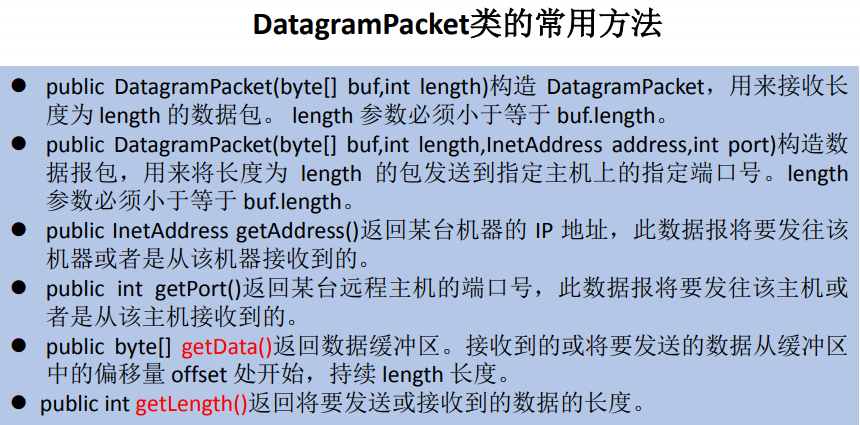
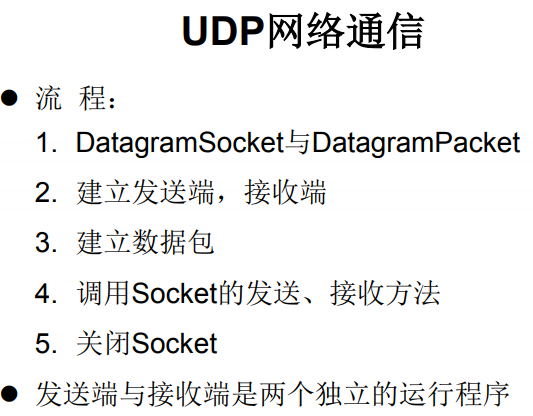

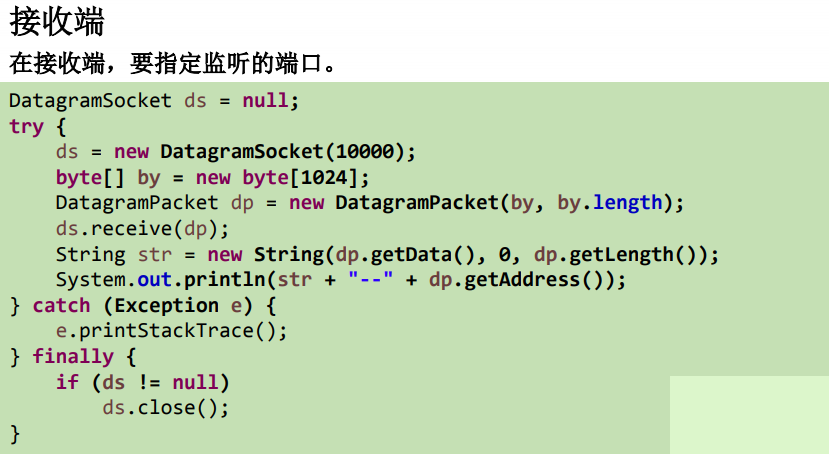

package com.atguigu.java1; import org.junit.Test; import java.io.IOException; import java.net.DatagramPacket; import java.net.DatagramSocket; import java.net.InetAddress; /** * UDPd协议的网络编程 * @author shkstart * @create 2019 下午 4:34 */ public class UDPTest { //发送端 @Test public void sender() throws IOException { DatagramSocket socket = new DatagramSocket(); String str = "我是UDP方式发送的导弹"; byte[] data = str.getBytes(); InetAddress inet = InetAddress.getLocalHost(); DatagramPacket packet = new DatagramPacket(data,0,data.length,inet,9090); socket.send(packet); socket.close(); } //接收端 @Test public void receiver() throws IOException { DatagramSocket socket = new DatagramSocket(9090); byte[] buffer = new byte[100]; DatagramPacket packet = new DatagramPacket(buffer,0,buffer.length); socket.receive(packet); System.out.println(new String(packet.getData(),0,packet.getLength())); socket.close(); } }
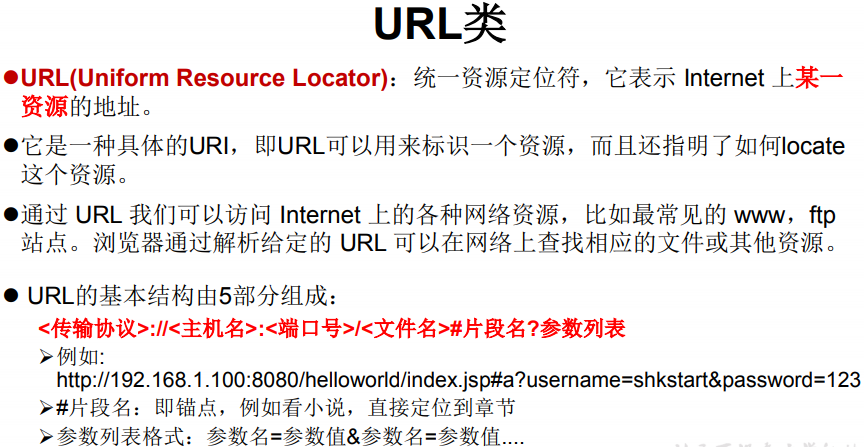
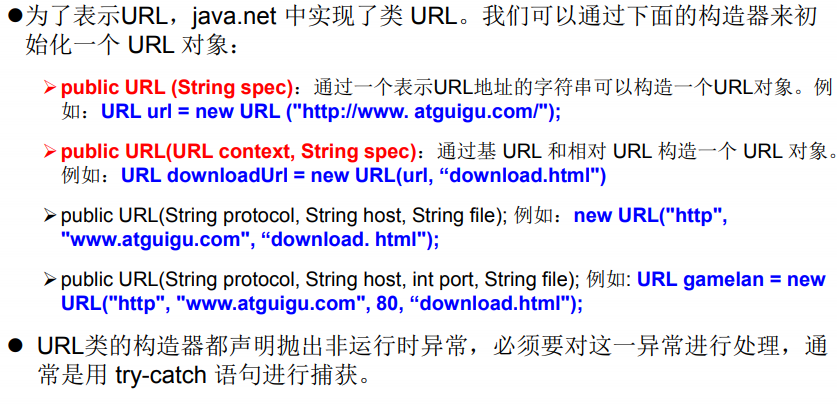
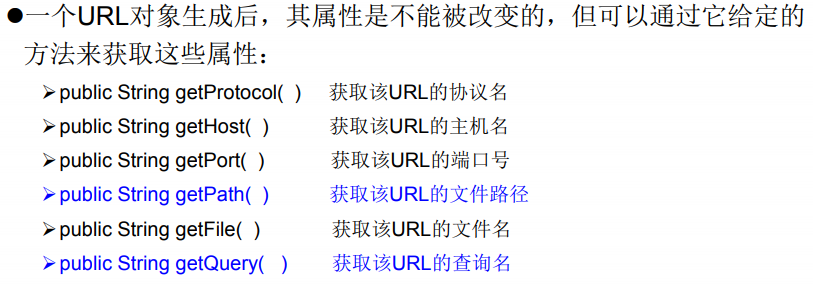

package com.atguigu.java1; import java.net.MalformedURLException; import java.net.URL; /** * URL网络编程 * 1.URL:统一资源定位符,对应着互联网的某一资源地址 * 2.格式: * http://localhost:8080/examples/beauty.jpg?username=Tom * 协议 主机名 端口号 资源地址 参数列表 * * @author shkstart * @create 2019 下午 4:47 */ public class URLTest { public static void main(String[] args) { try { URL url = new URL("http://localhost:8080/examples/beauty.jpg?username=Tom"); // public String getProtocol( ) 获取该URL的协议名 System.out.println(url.getProtocol()); // public String getHost( ) 获取该URL的主机名 System.out.println(url.getHost()); // public String getPort( ) 获取该URL的端口号 System.out.println(url.getPort()); // public String getPath( ) 获取该URL的文件路径 System.out.println(url.getPath()); // public String getFile( ) 获取该URL的文件名 System.out.println(url.getFile()); // public String getQuery( ) 获取该URL的查询名 System.out.println(url.getQuery()); } catch (MalformedURLException e) { e.printStackTrace(); } } }

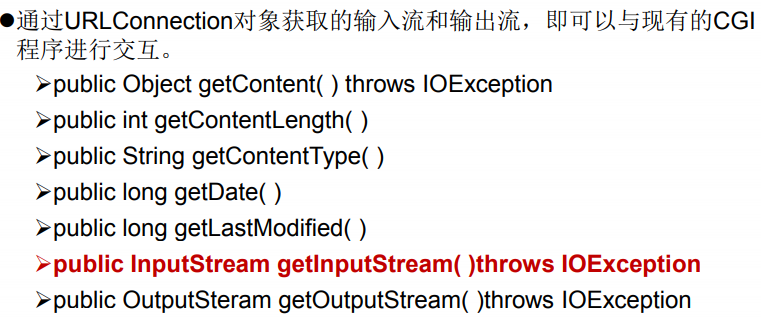

package com.atguigu.java1; import java.io.FileOutputStream; import java.io.IOException; import java.io.InputStream; import java.net.HttpURLConnection; import java.net.URL; /** * @author shkstart * @create 2019 下午 4:54 */ public class URLTest1 { public static void main(String[] args) { HttpURLConnection urlConnection = null; InputStream is = null; FileOutputStream fos = null; try { URL url = new URL("http://localhost:8080/examples/beauty.jpg"); urlConnection = (HttpURLConnection) url.openConnection(); urlConnection.connect(); is = urlConnection.getInputStream(); fos = new FileOutputStream("day10\beauty3.jpg"); byte[] buffer = new byte[1024]; int len; while((len = is.read(buffer)) != -1){ fos.write(buffer,0,len); } System.out.println("下载完成"); } catch (IOException e) { e.printStackTrace(); } finally { //关闭资源 if(is != null){ try { is.close(); } catch (IOException e) { e.printStackTrace(); } } if(fos != null){ try { fos.close(); } catch (IOException e) { e.printStackTrace(); } } if(urlConnection != null){ urlConnection.disconnect(); } } } }

